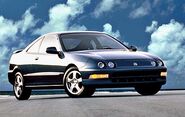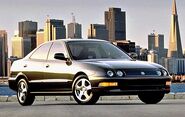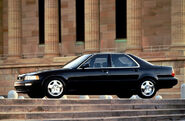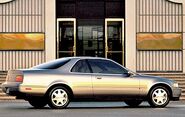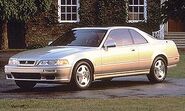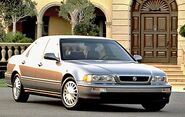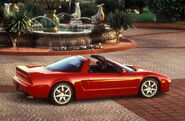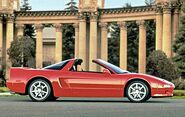Acura was the first of the spinoff luxury brands from a Japanese automaker. Honda, which spun it off, did everything just right: Franchise laws prevented the opening of new Honda dealerships too close to existing ones. By creating a new nameplate (Acura), it was able to open more dealerships in the profitable urban areas, where Honda already had considerable strength, and to ignore the areas less likely to buy imports. The upscale positioning of Acura was good for Honda's entire image. In 1994, just over 1 million Acuras were sold, with the Acura Legend representing the majority.
Acura Integra
The Integra was based on the Honda Civic platform, and Civic owners may have recognized some familiar knobs, switches and other hardware. However, styling and drivetrains differed significantly from the Civic. Ever since its introduction, the Acura Integra was among the most desirable sports coupes, and sedans, on the market.
1991
Originally, the Integra consisted of a 2-door hatchback and a 4-door sedan, as GS (Grand Sport), LS (Luxury Sport) and RS (Regular Sport) models. The GS sedan contained a standard power sunroof.
1992
In 1992, a new GS-R (Grand Sport Racing) model for the 2-door hatchback was added to the lineup.
1993
The 1993 Integra added new leather upholstery as standard, a rear spoiler, and bigger tires on alloy wheels.
1994
Redesigned for the Integra's third generation in 1994, the GS was discontinued, leaving behind the GS-R, LS and RS, all of which were available as either a coupe or sedan.
1995
The Integra line was only lightly revised for 1995. A new Special Edition (SE) was slotted between the base LS and high-performance GS-R models. It concentrated more on affordable luxury than high performance, and used the same front sway bar as the GS-R, 5-spoke 15-in. alloy wheels, body-color side molding, a woodlike treatment on the console of the sedan and a rear spoiler with integral brake light on the coupe, with the SE badging on both.
The high-performance GS-R now included leather as an option, while the base LS had a power moonroof as standard. The standard-engined LS and SE models competed with the Infiniti G20 and Honda's own Honda Accord. The GS-R with the 170-hp VTEC engine was in a class by itself.
1996
The RS sedan and the SE were discontinued in 1996.
1997
The GS (Grand Sport) returned to the lineup as a coupe or a sedan, replacing the SE, and a new CD player replaced the cassette player for the RS 2-door coupe.
1998
The RS coupe's last model year occurred in 1998. Other than that, all Inte
gra LS, GS and GS-R models featured new front and rear facias, new headlight and taillight lenses and new front and rear combination lamps. All these models were available in 3- and 4-door body styles.
Acura Legend
1991
During the second-generation Acura Legend's first three years, it was available as a 2-door coupe (L and LS) or a 4-door sedan (base, L and LS).
1992
Standard for 1992 was a new passenger airbag on LS models, and cupholders were added to all models.
1993
All Acura Legend 2-door coupes were now given 230 horsepower.
1994
In 1994, the base sedan was replaced by a new GS sedan. This model, with its 3.2-liter 230-hp Type II V6, was one of the most powerful front-drive imports sold in America. Understeer was a problem with high horsepower and front drive, so Acura has made traction control part of the package along with sport suspension, dual-piston front brake calipers and VR-rated tires. It was the only sedan offered in the United States with a standard 6-speed manual transmission (the optional 4-speed automatic was more often ordered). The other trim/driveline levels made do with a standard 200-hp Type I V6. A 5-speed manual transmission was standard on the L, with the automatic optional. The automatic was standard on the LS. The Type II engine received its power advantage from more aggressive valve timing and a different version of the 3-stage tuned intake system.
The Legends (except the L sedan) had leather upholstery, an electric tilt/telescope steering wheel with memory that works in conjunction with the 8-way power seat, a 4-way power passenger seat, air conditioning and Bose stereo equipment. The L sedan had cloth upholstery standard, leather optional.
Unlike other manufacturers, Honda/Acura had developed its own ABS system. The traction-control system on the GS used the same wheel speed sensors as the ABS, combined with steering input and yaw angle to limit throttle and maintain traction.
1995
For the Acura Legend's last year, a limited-time-only Special Edition (SE) sedan was added to the Legend's lineup.
Acura NSX
Long before it was ever introduced, the NSX was stirring the interest and passion of knowledgeable car enthusiasts all over the world. The word was out. Honda was building a mid-engined exotic sports car. And knowing the thoroughness of Honda's engineering, and the resident passion for high performance within the walls of the Research and Development center at Tochigi, the car world knew that something to be reckoned was in the making.
And when it made its first appearance in 1991, the accolades poured in. Everyone's highest hopes had been fulfilled. The NSX was a milestone exotic that was destined to achieve a niche all its own.
1991
The NSX was designed to give Honda/Acura a technology and image leader. It featured a very advanced, mid-mounted 270-hp VTEC dohc V6. Other high-tech buzzwords included ABS, traction control, and aluminum chassis, body and suspension. The original idea was to provide Ferrari-like performance at Porsche prices. Its main competitors were the Porsche 911, Chevrolet Corvette ZR-1 and (on price, but not performance) the Mercedes-Benz SL320 convertible.
Over the years of its production, the only major changes have been price (up), color (more), the wheel/tire package (larger, lower profile), and the addition of an automatic transmission. By 1994, about 5000 have been sold. However, it was clear from news stories about angry NSX owners, complaining that the very high-performance tires wear out too quickly, that many buyers were unclear about the strengths and weaknesses of ultra-exotic sports cars. Those buyers would probably have been happier with more luxury and less temperament.
1995
In early 1995, the only NSX sold in the United States was an all-new NSX-T. Acura has declined to offer any official description, but "new technology" was promised along with "two variations." An open-roof NSX was assumed for the first time, along with more displacement to increase torque, and a fashionable 6-speed transaxle.
No one has ever offered a Formula One race car-style semi-automatic transmission, adaptive (not active) suspension, carbon fiber or other advanced composites in a genuine production car, all of which were other possibilities for the 1995 model year.
1996
The hardtop NSX returned in 1996.
1997
For 1997, the NSX flied the flag of performance. It was known as the best sports car ever built, winning countless accolades in the enthusiast press. From its all aluminum monocoque body to the 290-horsepower VTEC engine, with titanium connecting rods, the NSX was an engineering tour de force.
Unlike any other Acura vehicle, the NSX was completely designed, engineered and built by Acura's Research and Development group in Tochigi. The engineers who designed and developed it and the assembly technicians that were responsible for assembling it had all been hand-picked for their skill and dedication. Like the finest European exotics, each engine was completely assembled by a skilled technician. And each car was tested at maximum speed at Tochigi's high-banked oval track before being released for delivery.
The NSX remained unchanged for 1998.
Acura Vigor
1992
For three years, the Acura Vigor was sold as a mid-size 4-door sedan (in GS and LS models).
1993
The Vigor GS now included a passenger airbag.
1994
In its last model year, all Vigors now had standard dual airbags, and the Vigor GS also included a standard CD player. Due to poor sales, the Vigor was dropped in Spring 1994, and as a result, no new replacements for the Vigor were sold for the 1995 model year.
Acura TL
1996
In 1995, Acura underwent some changes. The new 1996 TL was one of them. This car was an upgraded, expanded version of the Vigor.
Inhabiting the near-luxury segment, the TL found formidable competition with the likes of the BMW 3-Series, Lexus ES 300, Mercedes-Benz C-Class, Saab 900 and Saab 9000|9000 and the Volvo 850 and Volvo 960|960. To prepare for such diversity, the new front-wheel-drive Acura was available in a sporty version pulled by a 2.5-liter 20-valve 5-cylinder called the 2.5TL. In more luxurious 3.2TL trappings with a 3.2-liter 24-valve sohc V6 under the hood, Acura hoped the TL will rise to the heights of the old Legend.
Both Acuras were equipped with wishbone suspension, coil springs and stabilizer bars. They had 4-wheel disc brakes, ABS and speed-sensitive, rotary-valve rack-and-pinion steering. Though the suspension systems were very similar, the one in the 2.5 was tuned for a firm, aggressive ride while that of the 3.2 was biased toward ride comfort rather than raucous behavior.
Like the Vigor’s, the 2.5TL’s powertrain was situated longitudinally, allowing for softer engine mounts and decreased vibration. In fact, the dual-stage-induction 5-cylinder came from the Vigor. The variable-induction V6 in the 3.2TL (also mounted front to back) was already proven in the Legend sedan and coupe. Both engines retained their original output and directed it through a 4-speed automatic transmission that was endowed with grade logic, which minimized gear hunting and enhances downhill braking and uphill acceleration. Optional traction control used the same wheel-speed sensors as the antilock brake system combined with steering input to control the throttle.
As applied to the 3.2TL, the $2550 Premium Package included traction control, a 4-way power passenger seat, sunroof and heated side mirrors. The 2.5TL gained leather-trimmed seats and a power sunroof with its Premium upgrade.
1997
A standard power moonroof was added to all TLs in 1997.
1998
This was the last year in which the 2.5TL was available in the lineup.
1999
The Acura TL's second generation, which only consisted of the 3.2TL, was redesigned to also include 225 horsepower.
Acura RL
1996
Replacing the old Acura Legend sedan, the 3.5RL was the largest, most luxurious vehicle Acura has ever built. With its standard 3.5-liter, 210-horsepower engine it delivered impressive performance in a silky smooth package. The RL was a premier luxury sedan with hand-selected, leather trimmed interior, rich wood accent, an Automatic Climate Control System, a power moonroof and an 8-speaker Acura/Bose music system with CD changer. Like all Acura sedans and coupes, the RL featured a double wishbone suspension derived from Formula One technology. It provided amazingly precise response and handling and exceptional ride comfort.
Acura CL
1997
The Acura CL was the newest member of the Acura family in 1996. It was also the first Acura to be entirely designed and built in the U.S. This contemporary luxury sports coupe was equipped with a 3.0 liter, 200 hp V6 engine. It was also available with a 2.2-liter, 145-horsepower inline four cylinder engine. Both engines were equipped with the groundbreaking VTEC system. Pioneered in the NSX, VTEC had broken the age old trade-off between low-end torque and high-end horsepower.
The CL standard equipment package included an Automatic Climate Control System, power windows and door locks, keyless entry system with integrated theft-deterrent system, 6-way power driver's seat, a power glass moonroof and a CD-equipped 6-speaker sound system.

